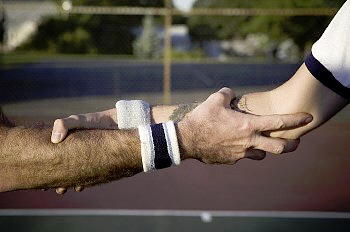Here are two (not very good) references that attribute the forearm handshake to the Romans, if not earlier, along with other interesting background regarding the forearm handshake and similar variations on the common modern handshake:
Shaking hands is a relic of our ancient past. Whenever primitive tribes met under friendly conditions, they would hold their arms out with their palms exposed to show that no weapons were being held or concealed. In Roman times, the practice of carrying a concealed dagger in the sleeve was common so for protection the Romans developed the Lower-Arm-Grasp as a common greeting.

Lower-Arm-Grasp
I can recall being given instructions on “a proper handshake” by my uncle as a skinny little kid growing up in Brooklyn. I was told that the custom dated back to Roman times - when men grasped not only one’s hand, but the entire forearm to ensure that the person you were greeting had no hidden weapons. My interest in history, even at that young age, re-enforced my understanding that this social expression was something to be taken seriously. I pass on the instructions I received any time a child or adolescent offers me a half-hearted handshake. My wife is even more dedicated than I about such social education. Over the years, I’ve heard the “hand-shake origin story” shift to medieval times as well as ancient Egypt. Whatever the truth behind the tale, the fact remains that the ritual has been around, more or less, forever. There have been variations on it -from the “soul brother” clasp that began in the 60s, to the similar “brothers in arms” grasp first used by many Vietnam vets, to the countless adaptations created by diverse social groups
Unfortunately, these references don't bring reliable sources for their contentions, although I personally can attest to witnessing in NYC the variations cited by Jim Kent in the '60's and the Vietnam War era, and noting that they were new for that period. I always understood that such gestures are related to the gesture of reassuring or encouraging someone to be strong and stalwart by firmly grasping their arm or shoulder. The two parties exchange such a gesture, encouraging each other to be strong and united. This makes sense, given that this sort of greeting was particular to groups that considered themselves "comrades in arms", etc., and so perhaps this sort of thing hearkens back to some ancient form of warrior greeting. Admittedly though, this amounts to nothing more than interesting speculation.
I suppose I can lay claim to being a "primary source" on such a thing, and IMO, when we encounter such forms of greeting today, they date back to those 1960's forms, just as do many other contemporary customs and stylesfashions.